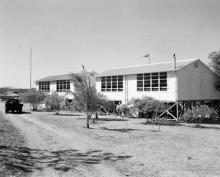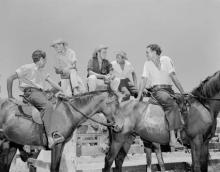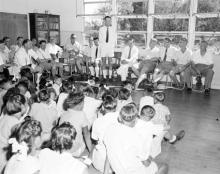Croker Island
Audio testimony of Harold Gurber, removed to Croker Island at 5 years old: http://stolengenerationstestimonies.com/index.php/testimonies/1019.html ; Clairey Henty-Gebert, Paint me Black: Memories of Croker Island and other Journeys: http://aiatsis.gov.au/publications/products/paint-me-black-memories-croker-island-and-other-journey… ; for an Indigenous account of the exodus, see Clare Henty-Gilbert, Crossing the Continent-My Memories, Perspective 18, no. 2 (1995) 19-24 ; see also Robert Randall, Songman, 43-75
-11.148648, 132.575837Aboriginal and Torres Strait Islander children from across the Northern Territory were forcibly removed to Croker Island . During World War II, following an air raid on Darwin, staff were ordered to evacuate, while the children were required to stay. Eventually, all the residents were able to leave . Former residents say that Croker Island often inflicted severe punishments in order to assimilate the children: "They just kept on flogging you, I don't know why. It seemed as though they had a joy to beat the living daylights out of you, to almost kill you. When you're nearly half dead then they'd stop beating you. I don't think the punishment and the crime that was committed was - we were only playing dodge the spear. We played it many, many times we'd played that game" .
1Established in 1940 by the Methodist Overseas Mission, closed in 1968.
Croker Island MissionNoah Riseman, 'Disrupting Assimilation: Soldiers, Missionaries and Aboriginal People in Arnhem Land During World War II' in Amanada Barry, Joanna Cruickshank, Andrew Brown-May (eds), Evangelists of Empire?: Missionaries in Colonial History (eScholarship Research Centre, 2008) 245, 258
Karen George and Gary George, Croker Island Mission (1940 Ð 1968) (4 August 2014) Find & Connect https://www.findandconnect.gov.au/ref/nt/biogs/YE00021b.htm
Tony Austin, Interview with Bobby Randall (Oral History Interview, Northern Territory Archives Service, TS 779, December 1993), quoted in Noah Riseman, 'Disrupting Assimilation: Soldiers, Missionaries and Aboriginal People in Arnhem Land During World War II' in Amanada Barry, Joanna Cruickshank, Andrew Brown-May (eds), Evangelists of Empire?: Missionaries in Colonial History (eScholarship Research Centre, 2008) 245, 248
NTWurundjeri Council
http://wurundjeri.com.au
City of Yarra, Wurundjeri History of Yarra - Introduction, City of Yarra
http://aboriginalhistoryofyarra.com.au/1-introduction/
I remember this woman saying to me, 'Your mother's dead, you've got no mother now. That's why you're here with us'. Then about two years after that my mother and my mother's sister all came to The Bungalow but they weren't allowed to visit us because they were black. They had to sneak around onto the hills. Each mother was picking out which they think was their children. And this other girl said, 'Your mother up there'. And because they told me that she was dead, I said, 'No, that's not my mother. I haven't got a black mother' (p. 134).
I found the Methodist Mission [Croker Island] very helpful and myself, from my experience, I really can't condemn the United Church, or Methodist Mission. Because they've been excellent to us. There were one hundred children and they showed a little bit of affection to each of us, y'know. They didn't show any favouritism (p. 354).
Confidential evidence 544, Northern Territory: woman removed to The Bungalow at 5 years in the 1930s; after seven years transferred to Croker Island Mission.
Human Rights and Equal Opportunity Commission, Bringing them Home: National Inquiry into the Separation of Aboriginal and Torres Strait islander Children from Their Families (1997)
5 years Confidential evidence 544
Croker Island Mission, 1958

Croker Island Mission, 1951

Croker Island Mission, 1958
